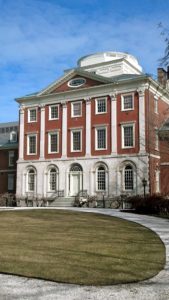by Katharina Lampichler
The medical education system in the US differs greatly from that in Austria. Students in the US first have to go to college and enroll in the so called pre-medical program. Basically any undergraduate major can be chosen if a certain set of medicine-related courses is also completed. Most of the students will focus on science majors but it would also be possible to study economy or arts, take some extra classes for pre-med and get into med school. At the end of college (usually 4 years), students have to take the MCAT (Medical College Admission Test) in order to apply for med schools.
After college graduation students enter the real medical school. Admission numbers vary greatly depending on reputation of the med school and number of applicants in that year. It is a 4 year program split into pre-clinical and clinical courses. During med school the famous USMLE steps have to be partly completed. The clinical courses are usually taken at hospitals students would like to apply for residency later on. One of the most important parts of the residency application process is the letter of recommendation from physicians that students worked with during their clinical training.
Medical students in the US are usually more involved in the clinical daily life than Austrian students. They get assigned to a specific intern or resident and usually work the same hours as the designated doctor including weekends and take care of their own patients. That way the students can experience how it is like to work as a doctor without having the full responsibilities. Although the med school training in the US is probably more intense than in Austria my perception is that final year students in both systems are on the same level when it comes to knowledge and clinical skills.
The downside of the American system is that private med schools cost around 50 000 dollars a year which means that every medical graduate has at least 200 000 dollars of debt while Austrians usually have none.
During the final year of med school students start to apply for a residency in their favorite speciality. The residency programs all have different durations and training schedules depending on subspeciality. The training can range from 3 years for internal medicine to 7 years for neurosurgery. There is also the possibility to apply for combined residencies (for example internal medicine and neurology).
After the written application process is finished, selected applicants are invited to interviews at their future hospital. The last step is the „match” (National Resident Matching Program). After the interviews every student and every institution creates a ranked list of their preferred applicants/ hospitals. The lists are then compared and the student matches a certain program and vice versa. Students are obligated to enroll in the program they have been matched to. It can happen that a student doesn’t match anywhere which means the application process has to be repeated the following year.
Once accepted to a program, graduates are called intern or junior resident (post graduate year 1, PGY-1). Some programs require a preliminary year of training in internal medicine before moving on to the desired speciality. Interns are assigned to a resident and/or attending and take care of patients on their own. There is a rotating schedule so interns and residents will experience every aspect of their chosen speciality. The big advantage of this system is that everyone starts at the same time of the year and every attending knows at which level the resident is (PGY-1, -2, -3,…) and what can be expected of the resident. So the more advanced the resident is within his/her training the more responsibilities regarding patient care and teaching students and other residents he/she has.
Generally the focus during residency clearly lies on teaching and gaining knowledge. At Pennsylvania hospital there are several teaching conferences every day exposing the residents to basic medical knowledge, case reports and board questions (and free lunch).
During my rotation in summer 2013, I did electives at the hematology/oncology, nephrology and infectious diseases service. Elective students are usually with the consult team whereas sub-i students work on the floors with the primary teams. The primary team admits and cares for the patient but can call for advice from other subspecialities or departments to further improve the patient’s treatment plan. This is called consult service.
When you get called from the primary team, one of the consult service team sees the patient and presents the patient’s history, physical examination and current treatment to the attending. Each patient is then discussed in the team and various topics are explained by the attending (treatment options, radiology reports, medication, follow up). Even though every attending has a different style of consulting and teaching and some days can get very busy, all of the attendings explain a lot and it is never a problem to ask questions. But it’s not just the attendings that teach, the residents know and teach a lot as well. Some of the third year residents even established a teaching seminar just for students where we could discuss the basics of internal medicine.
I really enjoyed working independently on a case and presenting it afterwards to my attending. Depending on how many consults we had, I could easily spent more than an hour on one patient to make sure that I understood the history and reason for admission or medications and treatment plans. If you have in mind what kind of questions your attending will ask it’s often easy to find a way through the chart to the bottom line of the patient’s story. And even if I sometimes didn’t fully understand something it became clear to me after discussing it with the team. And I personally think that’s how I learned the most: See patients, get the picture and then remember the whole process of finding the right answers and treatment.
It was really interesting to meet medical students from the US and listen to their stories of getting into med school and applying for residency. Before I came here I already knew some things about the educational and medical system in the US but I think now I have a good overall picture about patient care and doctor’s training here. It is quite different to Austria and every system has it’s good and not so good sides but it’s always important and fun to get to know people in the same position as yourself but from completely different systems and with different backgrounds. I would always recommend coming to Pennsylvania Hospital for a couple of educational and fun months (or longer).
If you want to contact Katharina Lampichler, please write us: office@goinginternational.org
Tip: More up to date educational events dealing with healthcare can be found online on the Education Database »medicine & health«.


